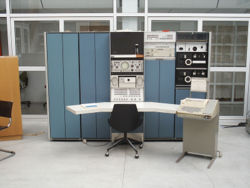Difference between revisions of "PDP-7"
m (fix cats) |
m (Proper cat) |
||
| Line 39: | Line 39: | ||
* http://heim.ifi.uio.no/~toresbe/dec PDP-7 restoration project located in Oslo, Norway | * http://heim.ifi.uio.no/~toresbe/dec PDP-7 restoration project located in Oslo, Norway | ||
| − | {{stub}} | + | {{semi-stub}} |
[[Category:DEC Systems]] | [[Category:DEC Systems]] | ||
Revision as of 16:15, 20 October 2018
| PDP-7 | |
 A PDP-7 in Oslo, Norway | |
| Manufacturer: | Digital Equipment Corporation |
|---|---|
| Year Introduced: | 1965 |
| Form Factor: | minicomputer |
| Word Size: | 18 bits |
| Logic Type: | PNP Transistor FLIP CHIPs |
| Memory Speed: | 1.75 μsec |
| Physical Address Size: | 15 bits (32K words) |
| Virtual Address Size: | 13 bits (direct), 15 bits (extended) |
| Operating System: | DECSYS-7 |
| Predecessor(s): | PDP-4 |
| Successor(s): | PDP-9 |
| Price: | US$72K |
The PDP-7 is a minicomputer produced by DEC. Introduced in 1965, the first to use their Flip-Chip® technology, with a low cost, it was cheap but powerful. The PDP-7 was the third of Digital's 18-bit machines, with essentially the same instruction set and architecture as the predecessor PDP-4 and successor PDP-9. It was the first wire-wrapped PDP.
In 1969, Ken Thompson wrote the first UNIX system in assembly language on a PDP-7, then named Unics as a somewhat treacherous pun on Multics, as the operating system for Space Travel, a game which required graphics to depict the motion of the planets. A PDP-7 was also the development system used during the development of MUMPS at MGH in Boston a few years earlier.
There are a few remaining PDP-7's still in operable condition, along with one under restoration in Oslo, Norway.
Emulation
The PDP-7 can be emulated with SIMH. DECSys and some other software is available and can run on the emulator.
External links
- "The famous PDP-7 comes to the rescue" (Bell Labs' Unix history)
- http://research.microsoft.com/~gbell/Digital/timeline/1964-3.htm PDP-7 entry from Year 1964 in the DIGITAL Computing Timeline
- http://heim.ifi.uio.no/~toresbe/dec PDP-7 restoration project located in Oslo, Norway